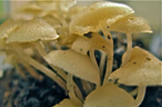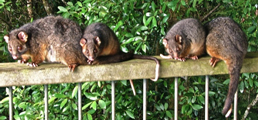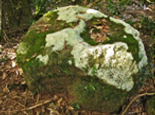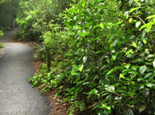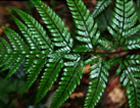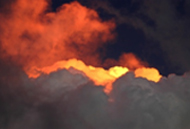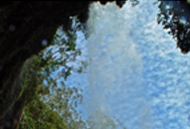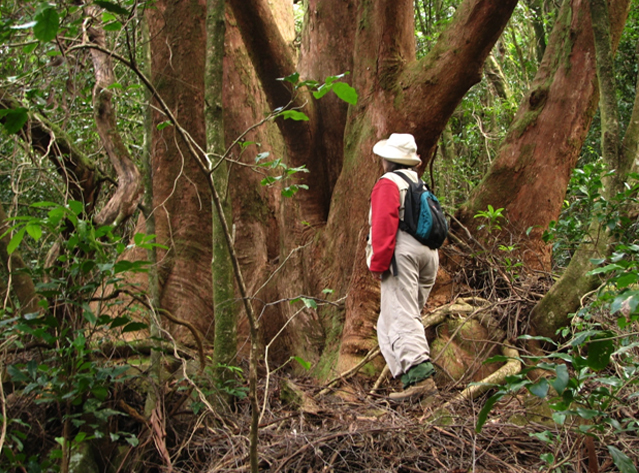Springbrook Rescue is almost entirely based on volunteers, with people coming from far and wide, from diverse backgrounds, to help the Queensland Parks and Wildlife Service recover one of the most significant natural areas in the world. Because of the remote location and long hours working in the field, volunteer accommodation is vital to the sustainability and ultimate success of the mission. The most rewarding way we’ve found to help nature recover is to involve people from self-organising groups, already attuned to nature and each other, to work together with us as part of this long-term journey of renewal. So much more can be achieved when people trust and enjoy each other’s company and can see their combined efforts really make a difference. Our groups mainly involve bushwalkers, “birdos”, naturalists, ARCS members, music groups, church and other conservation groups, or friends who self-organise to come as a group. Any group supporting our goals is welcome.
Volunteer Accommodation The volunteer accommodation (the Lodge) for the Springbrook Rescue project is located at 317 Repeater Station Road, Springbrook, 36 km from Nerang or 24 km from Mudgeeraba (the nearest townships in the Gold Coast hinterland), or 120 km from Brisbane, the capital of Queensland. If travelling from Brisbane exit the Pacific Motorway at Nerang (exit 69) or from Mudgeeraba (exit 79). The Lodge is 3.17 km from the turnoff from Springbrook Road into Repeater Station Road. From the Lodge there is only a short 15 minute walk to the “Best of All Lookout” where you have panoramic views from the edge of the Tweed Volcano caldera to Mt Warning/Wollumbin, other peaks of the McPherson Range to the east (the Cougals, and Boyds Butte), and Byron Bay and Coolangatta. The Lodge is perfect, too, for hearing and seeing iconic lyrebirds, logrunners, scrubwrens, ground thrushes. The olive whistler has now also been recorded on surveys. |
|||||||||||||||||||||||||||||||||||||||||||||||||||||||||||||||||||||||||||||||||||
 Mt Warning/Wollumbin from the Best of All Lookout.  The McPherson Range east of Best of All Lookout showing Mt Springbrook (with towers), the Cougals (the double peak) and Boyds Butte (the lower triple-peak to the left of the Cougals) in the middle distance. |
|||||||||||||||||||||||||||||||||||||||||||||||||||||||||||||||||||||||||||||||||||
History of the Lodge The Lodge and associated cabins were previously owned and loved by Brisbane-born Doug and Annette Robbins, who bought the 4 ha property in 1973. Tallaringa (Aboriginal for “over the trees” because of the view of the Gold Coast at the time over the trees) was the first structure to be built in 1976. They then designed the main lodge that was completed in 1983. Doug and Annette have provided ARCS with a video of the Lodge construction phase. It is truly amazing to see how they coped with the difficult terrain. Two small cabins were built later — “Possum Hollow” and “Fairy Bower” (named by the Robbins after the mountain possums and Fairy Wrens that frequented the site at the time). In February 2007, the property was bought, as vacant possession, by the Queensland Government as part of the Springbrook Rescue acquisition phase and ARCS was given use of the buildings to accommodate volunteers. The Robbins generously donated all furniture, fittings and everything else we needed to help ARCS provide adequately for our wonderful volunteers. The Lodge comfortably accommodates 15 people, an ideal group size. There are five self-contained bedrooms, each with a double bed. The fifth, larger shared bedroom has additional bunk and single beds to accommodate a further five. Up to 20 is possible if the loft and/or sofa bed in each of the four smaller bedrooms are used. Four identically appointed bedrooms each contain a double bed, sofa bed, and an extra single bed in the loft with a skylight to see the full moon on clear nights. There’s a bar fridge, tea-making facilities, together with an en-suite containing a shower and toilet. At the end of the corridor a fifth, larger suite of several rooms accommodates a maximum of seven people. A communal bedroom comprises two double bunks and single bed. The main room contains a double bed, kitchenette with bar fridge, tea-making facilities, and a dining table for seven. In addition there are minimalist laundry facilities and an en-suite with shower/bath and toilet. The Lodge has a fully equipped kitchen, a communal lounge with a central fireplace, a dining room accommodating 24 visitors, and a project room with a small conference space. The Project Room doubles as a seminar room and is equipped with white board, poster panels, projection facilities, DVD player and display, tables and chairs. Specialist equipment is available, e.g. microscopes and drying towers for mycologists. |
|||||||||||||||||||||||||||||||||||||||||||||||||||||||||||||||||||||||||||||||||||
 The dining room for 24 people |
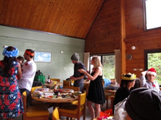 View 2 of spacious dining room |
 Communal lounge & fireplace |
 Project/seminar room |
||||||||||||||||||||||||||||||||||||||||||||||||||||||||||||||||||||||||||||||||
Cabin accommodation The Lodge parking area How you need to prepare What you will need to bring The weather on Springbrook can be very variable because of the diverse topography. It can be sunny at lower altitudes and raining or immersed in cloud when you reach the Lodge. Temperatures are at least 8–12 degrees cooler than on the coast and the high ridges are often shrouded in cloud. The Lodge is within the highest rainfall zone on the Springbrook plateau. [Have a look at our web page on Climate under the “Springbrook, a natural wonder” section.] In the first years of settlement the longest dry spell was reportedly 10 days. Springbrook has the highest annual rainfall on mainland Australia outside the Wet Tropics. The highest rainfall ever recorded in any one year was 5648 mm in 1974 at the old Forestry Station on Springbrook Road in upper Springbrook. Higher values are routinely recorded at the highest altitudes, but records show a distinct drying trend over the last 20 years most likely due to global climate change. These high altitudes are still frequently immersed in cloud so that bryophytes (mosses, liverworts and hornworts) festoon most of the trees and shrubs. Bryophytes play a vital role in forest hydroecology.
Choice of things to do during spare time Relaxing around the fireplace: After a day working in the field, surveying, digging out Aristea ecklonii, nothing could be better than relaxing together around the fire, sharing stories and fine food. Some groups bring musical instruments, so wonderful in this era of “passive” entertainment. Otherwise, there is some light reading to while the evening hours away. Talks and videos about Springbrook Rescue or wildlife: For weekend visitors, we give a PowerPoint presentation on the Springbrook Rescue project on a Saturday night. The Project Room on the ground floor of the Lodge also has a DVD player and display for choosing from a range of videos or slides showcasing Springbrook plants, fungi, invertebrates, frogs, reptiles and birds observed, or discovered for the first time, since the Springbrook Rescue project began. We have some unique footage of animal behaviour never seen before that has been captured on our remote cameras. Groups can show their own slides or videos too. The venue is the Project Room on the ground floor of the Lodge. Stargazing: The pure, clear mountain air at Springbrook is perfect for stargazing. Near the Lodge one gets a panoramic view of the southern skies. Those of you with an iPhone or equivalent should ensure you have “The Night Sky” app to easily identify the planets, stars or constellations visible above us on any particular clear night. Doing this as a group activity during those spare moments, weather permitting, can be a wonderful experience rarely possible on the polluted lowlands. For ‘gazing’ appassionados, even better views with powerful telescopes, André Clayden at the Springbrook Observatory on 2337 Springbrook Road is worth a visit (by appointment only). Glow-worms and other luminescent organisms: There are mini glow-worm caves (rock crevices) and roadside banks festooned with bioluminescent threads only a short walk away from the Lodge. Glow-worms at Springbrook are actually the larvae (not worms) of the primitive Gondwanan fly Arachnocampa flava, endemic to south-east Queensland–NE NSW and best seen during the warmer, wetter months from December to March. Fireflies can also sometimes be seen mainly for a very short period in late Spring–early Summer. Glowing fungi can be seen best during the wetter months. There are only 71 species of luminescent fungi known from around the world, and 75% of these are in the Mycena genus. It’s thought the ability to glow was more widespread but lost in many plant lineages. Fungi may glow to attract nocturnal animals for dispersal of their spores. Several species occur at Springbrook: Omphalotus nidiformis, Dictyopanus pusillus, Filoboletus manipularis, Panellus stipticus and some Mycena species. For real enthusiasts, you may want to visit Springbrook Glow Worm and Research Centre on 2509 Springbrook Road (by appointment only).
Observing other night creatures: Those of you interested in trap-door spiders will be able to inspect these ancient megalomorph creatures during a guided walk only minutes away from the Lodge. At the same time you may see or hear ringtail possums, the mountain brushtail, Boobook Owl, even Sooty Owls during the right time of year, or see ancient dung beetles, different wingless King Crickets, giant panda snails coming out after heavy rain. When very wet, you may see the Giant King Cricket (Anostostoma australasiae, family Stenopelmatidae). These only occur in rainforests of SEQ and NE-NSW. The crickets live in burrows in the soil and emerge on wet nights to forage on the rainforest floor for live insects, fungi and rotten fruit. The giant wetas of New Zealand arose from Australian ancestors in Australia 300 Ma ago. Many other King Crickets frequent the Lodge precinct. During the limited early wet, warm summer months you could be lucky to hear Kyarranus loveridgei, the threatened masked mountain frog or Assa darlingtoni, the pouched frog. If spotlighting, a torch with a red filter is necessary to protect animals’ eyes.
Daytime activities Bushwalks Additional walks for Springbrook Rescue volunteers include the Lodge Track (in National Park (Recovery)), and on ARCS-owned “Ankida”, the Waterfall and Escarpment Tracks which are not open to the general public. The Lodge Track (Class 5). Good fitness required, steep in places, the track is only marked by biodegradable pink tape. Caution is required to avoid slipping on loose rocks so ankle-protecting footwear is essential. This track is only available to Springbrook Rescue volunteers who are involved in surveys. Birds Queensland conduct seasonal surveys on this track each year. Expensive audio-monitoring sites and Wireless Sensor Network nodes exist along this track which are important to avoid especially to prevent damage to sensitive soil sensors. Thirty-six bird species have been recorded; lyrebirds, logrunners, scrubwrens, ground thrushes, topknot pigeons and riflebirds are a highlight. During a short summer interval you can hear the threatened frog Kyarranus loveridgei in the wettest spots. To date 125 plant species have been recorded. A map and detailed description of vegetation and other aspects of interest along the track is available in the Lodge library.
Ankida Waterfall Track (Class 3). This formed track is on ARCS owned land and is only open to Springbrook Rescue volunteers and only by agreement with ARCS as part of formal surveys. This is a 2 km return track of varying steepness, and takes at least 1 hour to walk. Horseshoe Falls (a 100-m drop) overlooks the beautiful Waterfall Creek valley. It has the richest diversity of birds, fungi and frogs anywhere on Springbrook. This is one of the formal survey transects studied by Birds Queensland. Eight-five bird species have been found to date including the Glossy Black-Cockatoo. So far, 625 plant species have been found on Ankida.
Ankida Escarpment Track (Class 3). This unformed track (~ 1.14 km of essentially flat land to the edge of the escarpment; a further 300 m along the escarpment; marked discretely with biodegradable pink ribbon) is also on ARCS owned land. The round trip of 2.88 km takes at least 2 hours. As above, the diversity of birds, plants, fungi etc. on Ankida is very high with rare plant communities and rare species seen along the way. The views from the escarpment are good. In the future the track with link back to the Waterfall track creating a 3.2 km round trip of great diversity of environments, scenery and wildlife.
National Park tracks Best of All Lookout Track (Class 2) — a hardened, 700 m return walk through the rarest relict forest type on Springbrook — cool temperate Antarctic Beech forest, and most threatened by global warming; takes about 15-30 min. Most is actually in New South Wales. Understorey vegetation appears much thinner than in the past so many of the rare plant species that used to delight visitors are now difficult to find. This is prime habitat for Albert’s Lyrebird and the Bassian Thrush. The Rufous Scrub-bird was last recorded here in 1991. A tantalizing call was heard once in December 2012 but seems likely to have been an errant wanderer from the adjoining NSW Numinbah Nature Reserve. The Rufous Scrub-bird requires a dense understorey. Logrunners, Yellow-throated Scrubwren and Riflebirds are often to be seen and heard on this track.
Twin Falls Circuit (Class 3). 4 km return from Tallanbana picnic area or Canyon Lookout. Takes about 1.5–2 hours. A beautiful walk, including behind the waterfalls. All photos are by Mark Ash.
Warrie Circuit (Class 4) (17 km return, 5–6 hrs). Warrie is Aboriginal for “rushing water” because of all the waterfalls (11 of them), cascades and at least eight creek crossings. Starts at Canyon Lookout following the base of the canyon cliffs to Goomoolahra Falls then descends to Meeting of the Waters where all the watercourses draining into the canyon meet (Boy-ull, Ee-Jung, Mundora and Little Nerang Creek (East Branch)). Along the way you’ll pass through montane heath, dense rainforests with majestic trees and drier eucalypt forests. You’ll be able to see the Giant Spear Lily (Doryanthes palmeri, one of only two members of the endemic Doryanthaceae plant family), giant Red Cedar and Brush Box trees, orchids and other epiphytes, and lots of birds. All photos are by Mark Ash.
Apple Tree Park walk (2016 Springbrook Road). This is well worth stopping here before you arrive at Springbrook or on returning home. Within a short walk one could expect to see up to 30 birds or more including the Yellow-faced Honeyeater and White-naped Honeyeater, Brown Thornbill, Striated Thornbill, Spectacled Monarch, Spotted Pardalote, and even the Glossy Black-Cockatoo if you’re lucky. This is high-quality tall open eucalypt forest with a high density of large, old trees one to 1.5 metres across with lots of hollows and branch-base dwelling orchids. There are barbeque and picnic facilities. Bird watching: Apart from Birds Queensland who are routinely involved in seasonal bird surveys, other volunteers will be able to see or hear a wealth of birdlife on the Springbrook plateau during their visit. As many as 185 bird species have been recorded at Springbrook. These include the oldest lineages of songbirds on earth. Few places allow you to see so many in such a small area. The smart phone app “The Michael Morcombe eGuide to the Birds of Australia” is a wonderful field guide to have with you on your bird watching walks. Cloud watching: Those with a passion for clouds will find Springbrook one of the best places to see all possible cloud formations imaginable within a short period of time. From the Best of All lookout you can also sometimes see sheets of clouds rolling off the plateau over the caldera edge like a giant waterfall. A DVD of the phenomenon was provided by ecologist and talented photographer Lui Weber and is available for viewing in the Project Room. There is even a “Cloud Appreciation Society” website with over 25,000 members. To find out more check www.cloudappreciationsociety.org. Reading the clouds is a rare ability but important for planning restoration activities.
Plant identification: Springbrook is a plant lover’s paradise. There are at least 1,200 plants many of which are of such immense phylogenetic and evolutionary significance that they provide a fundamental basis for the outstanding universal value of the Gondwana Rainforests of Australia World Heritage Area. The short tracks connecting the Lodge, cabins and Robin’s Nest provide a good opportunity for self-guided identification of the more common local plants most likely to be seen during visits. Copies of the ARCS identification field guide for rainforest plants “Fragments of Green”, by Janet Hauser and Jan Blok, are available in the library as a reference book or for sale. An order form can also be downloaded from the ARCS website Arts and Craft Galleries, eating places etc: Craft Corner Gallery Eating Places Dancing Waters Café: Located at 33 Forestry Road next to the Purlingbrook Falls walking track, the café is open seven days a week providing morning teas and wonderful vegetarian, vegan and gluten free lunches made with love and care. Proprietor, Anastasia Theodore, has transformed the building since she took over in 2007. Evening dinners are not normally provided. Puddleducks Café, opposite Wunburra Lookout as you first enter Springbrook, is one of the oldest eating places on Springbrook. It was built in the 1920s. It is open every day except Tuesday and Wednesday with dinners available Friday and Saturday nights (bookings necessary). For further information check their website: www.puddleduckscafe.com/ Scuttlebutt Café and Restaurant, 2319 Springbrook Road, is open from Wednesday to Sunday from 10 am until 8 pm each day. This café is the only place on Springbrook that provides dinners five nights a week (Wednesday, Thursday and Sunday nights, in addition to Friday/Saturday that two other outlets provide), however dinner bookings on these evenings is necessary. The Fudge Shop: at 3 Lyrebird Ridge Road is famous for its fudge, freshly made in the shop each day, as well as for its coffee, gourmet ice cream, jams, locally made honey and other rainforest treats and Patti Flynn hand-made soaps that make appealing gifts. Some more photos highlighting special aspects of or places near the Lodge
|
|||||||||||||||||||||||||||||||||||||||||||||||||||||||||||||||||||||||||||||||||||









